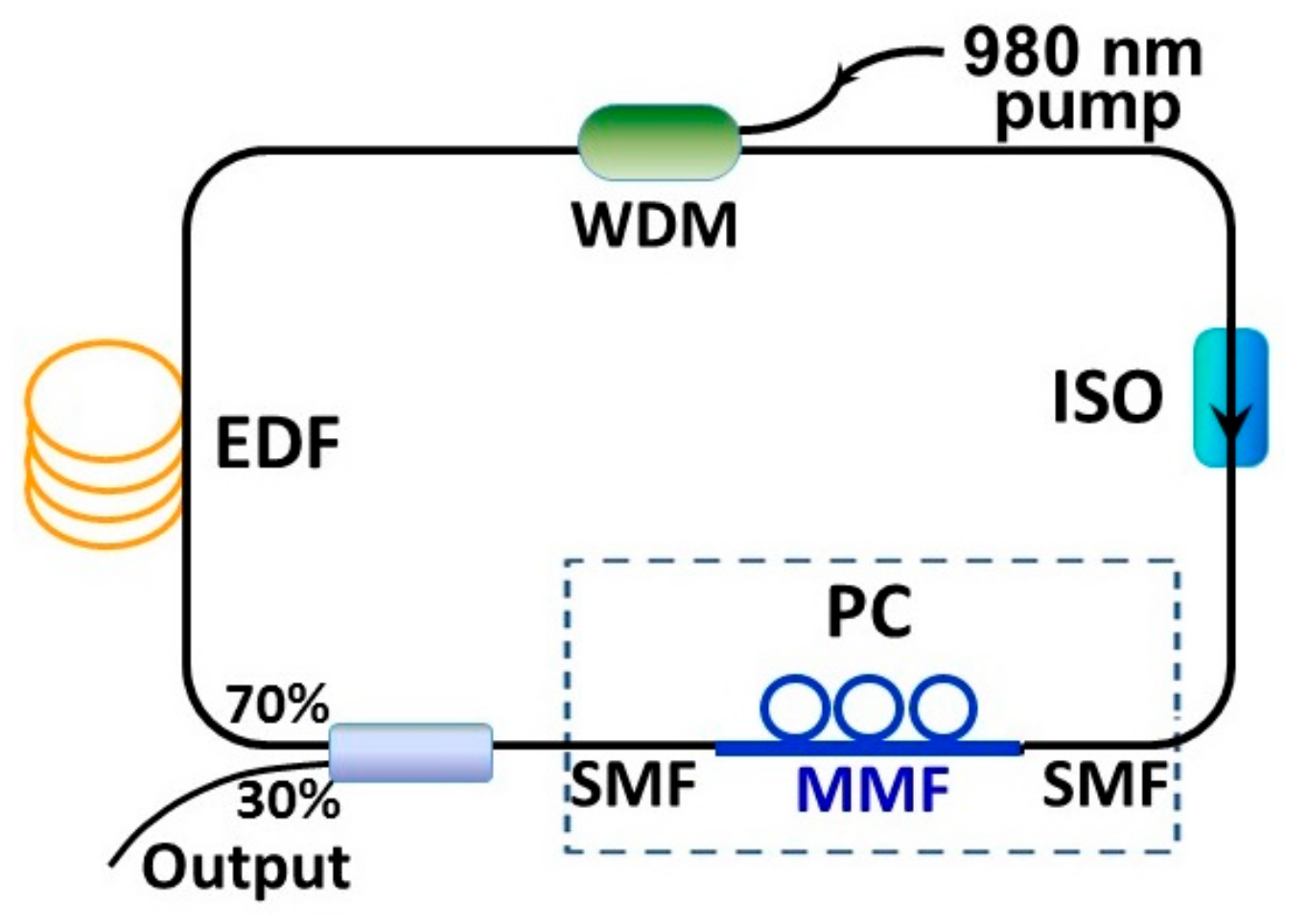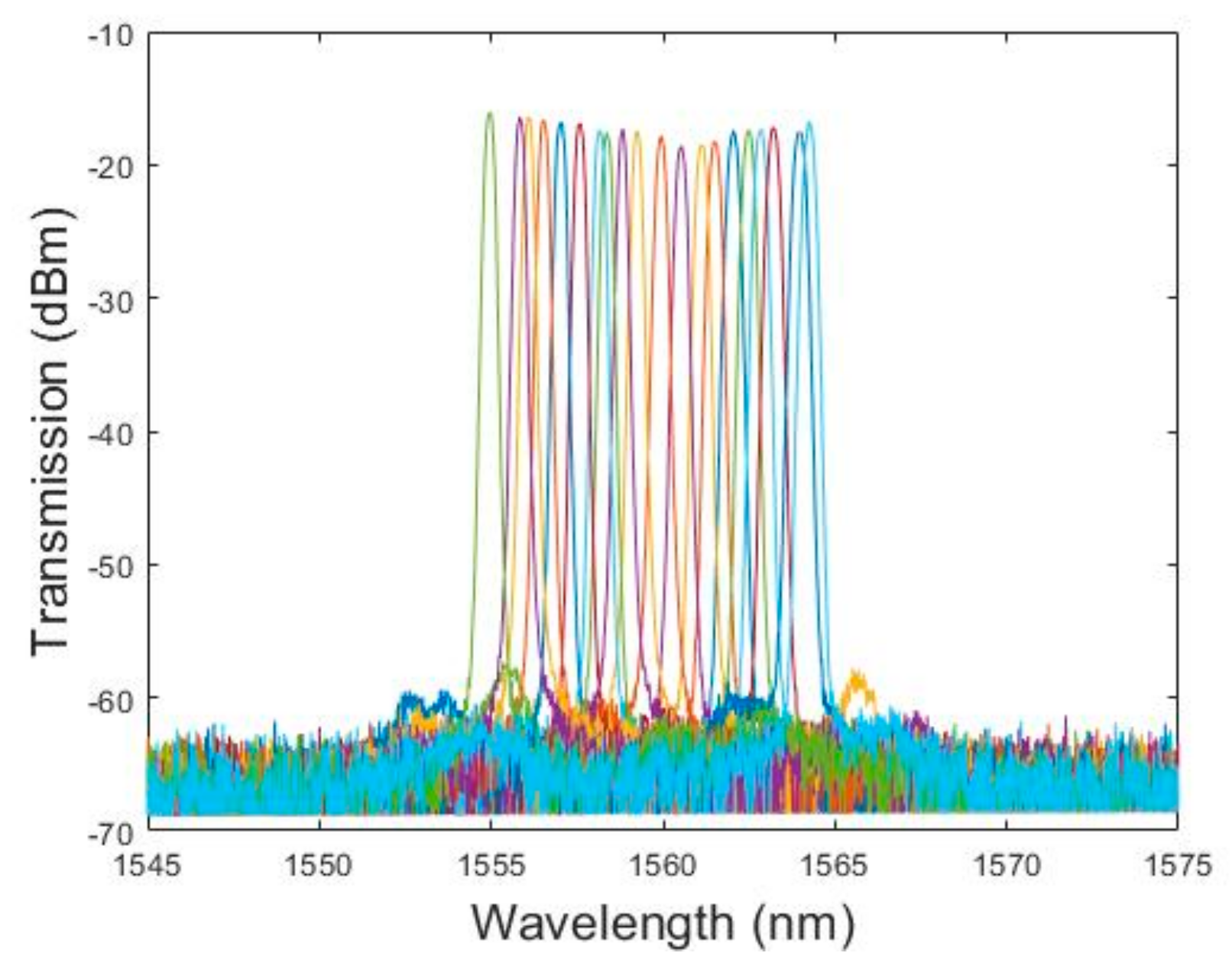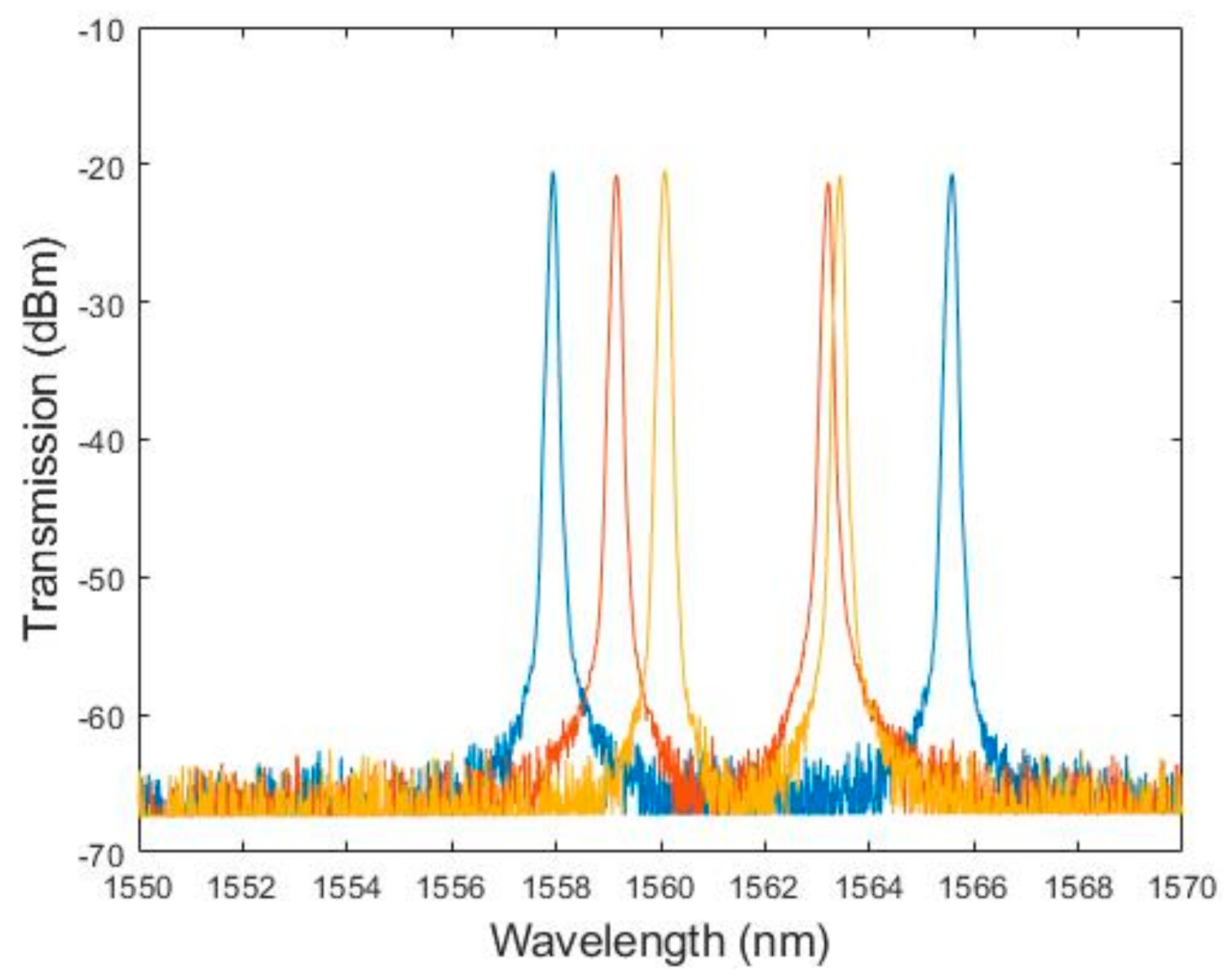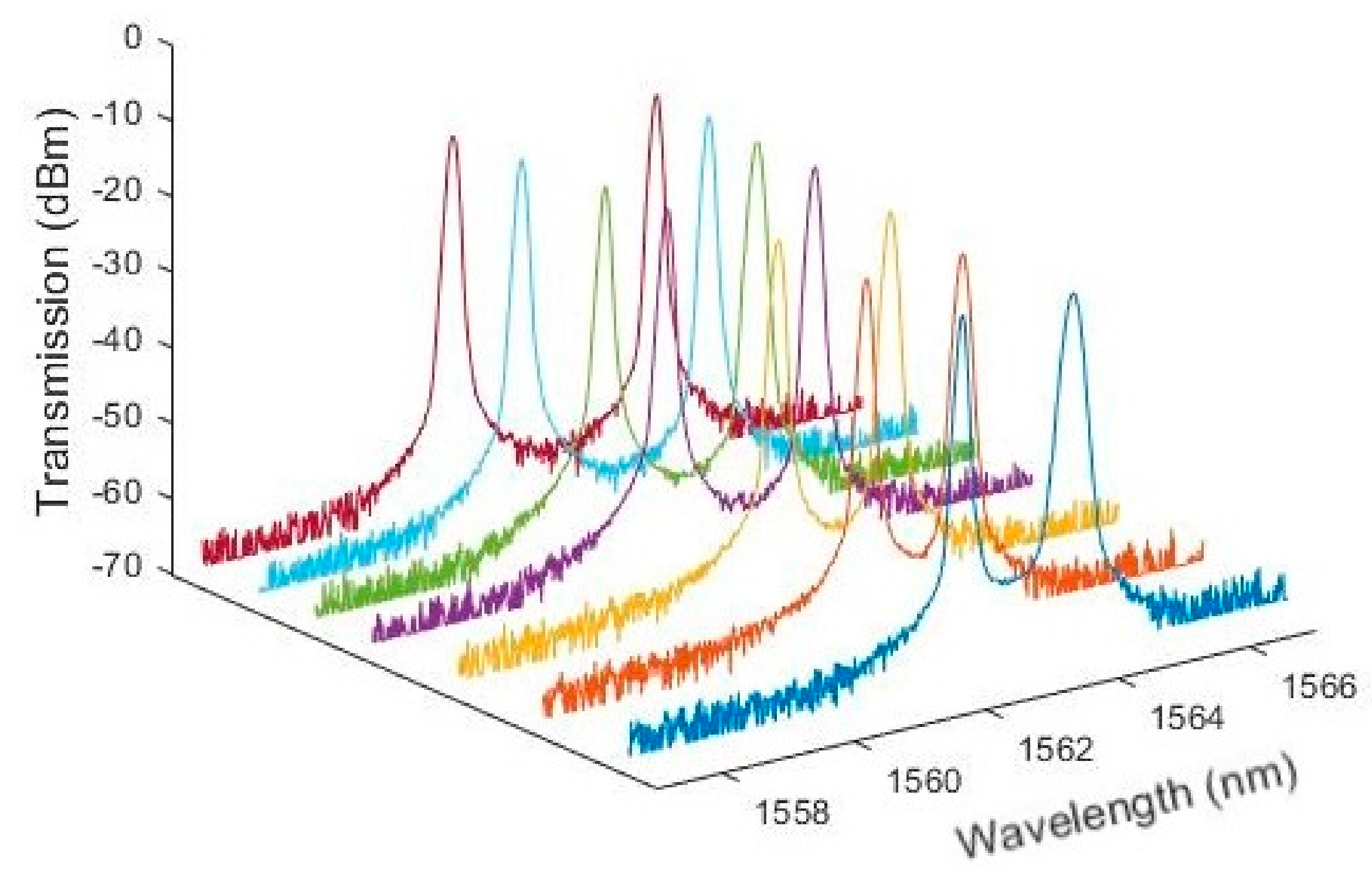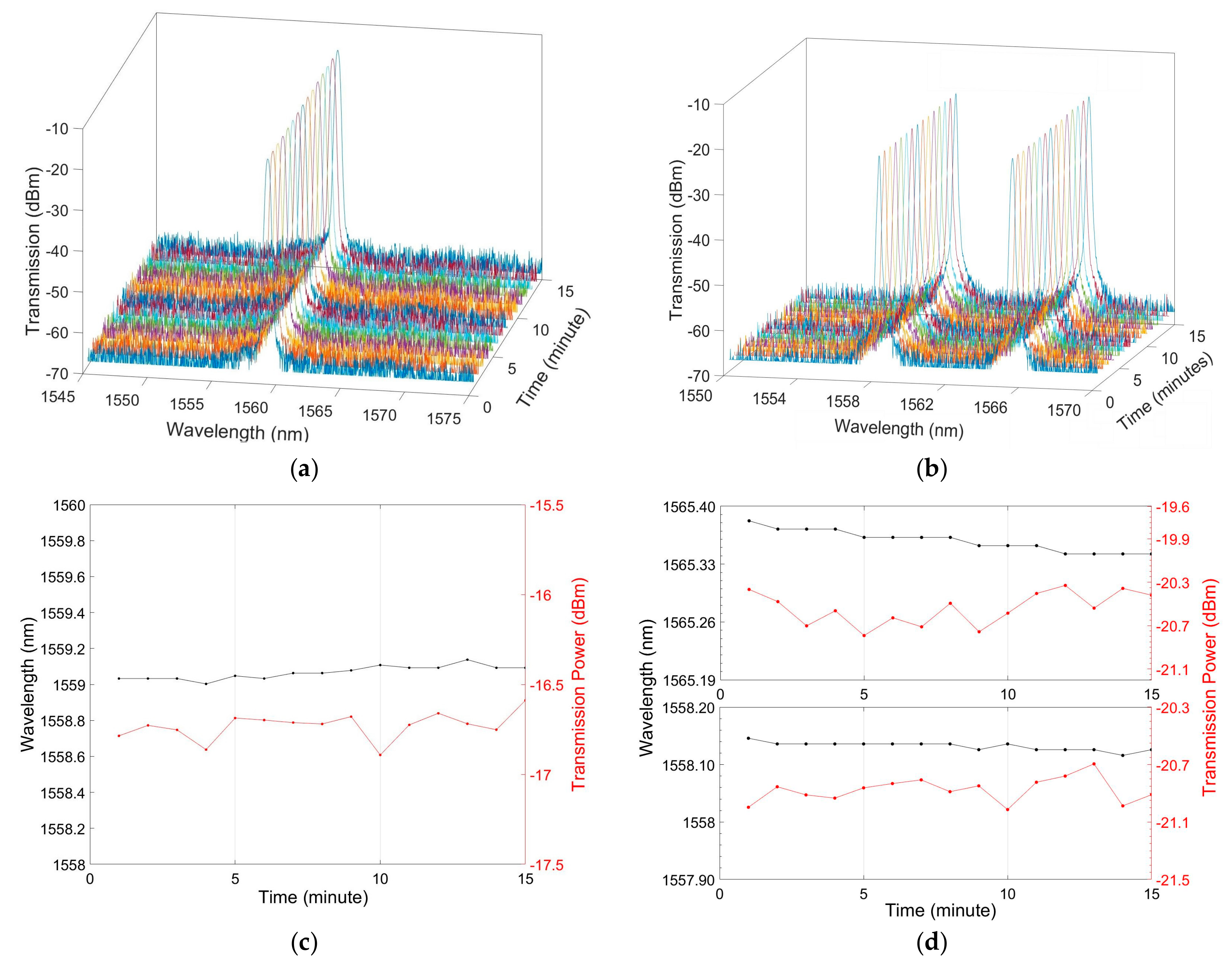1. Introduction
Fiber lasers have attracted intensive research interests in the past few decades and have become the fastest growing field in the laser community due to their wide industrial applications in telecommunications, material processing, and sensors, etc. In particular, switchable and tunable erbium-doped fiber lasers (EDFLs) that are able to switch from single-wavelength to multi-wavelength output, as well as tunable capability, have been attractive to applications, such as optical instrument testing. Due to the nature of the homogeneous broadening effect of the erbium doped fiber, it is challenging to achieve a stable multi-wavelength operation. Multiwavelength EDFLs have been demonstrated by using different schemes, for example, cascaded fiber Bragg gratings (FBGs) [
1], four-wave-mixing of dispersion shifted fiber [
2], nonlinear polarization rotation [
3], and various fiber-optic interferometers (FOIs) [
4,
5,
6,
7,
8,
9,
10,
11,
12,
13,
14,
15,
16]. Among them, much of the research attention has been recently paid to employ FOIs to generate multiwavelengths. An FOI can be constructed with a pair of long period gratings (LPGs) [
4], sandwich-structured single-mode fiber (SMF) driven by an acoustic transducer [
5], a fiber loop mirror (FLM) incorporated with one or two sections of high birefringent fibers [
6,
7,
8,
9] or a combination with hollow-core Bragg fiber [
10], and modal interference by using fiber tapers [
11,
12,
13] or multimode fiber (MMF) [
14,
15].
Although the switchable function from single- to multi-wavelength is readily realized by adopting a polarization controller (PC) [
6,
8,
9,
11,
14] or a variable optical attenuator (VOA) [
13,
15] in the cavity, it is highly desirable that, in the meantime, the laser wavelength and wavelength spacing could be tunable for practical applications. Many efforts have been devoted to the tunable and switchable multiwavelength fiber lasers. Zhao et al. [
10] demonstrated a switchable EDFL with a tunable range of 3.4 nm for single wavelength operation by using two PCs. With three PCs, Zou et al. [
7] realized a switchable EDFL, with a tunable wavelength spacing. Another approach by using a combination of a PC and a rotary fiber squeezer inserted with multi-mode fiber (MMF) has been implemented to attain a tunable multiwavelength thulium-doped fiber laser (TDFL) [
16] and a wavelength spacing switchable TDFL [
9]; nevertheless, the lasers suffer from a high insertion loss of the multimode interference filter in the rotary squeezer [
9] and a relatively high power fluctuation for dual-wavelength operation [
16]. He et al. [
17] recently reported a tunable multiwavelength EDFL with a polarization maintaining FBG (PM-FBG) and a Mach-Zehnder interferometer (MZI); although wavelength spacing can be changed by a variable fiber delay line (VDDL), the tuning range is limited by the bandwidth of the PM-FBG. Im et al. [
18] demonstrated a tunable single and dual-wavelength EDFL using an FLM with a high-birefringence photonic crystal fiber (PCF); while a tuning range of 12 nm for the single wavelength mode was obtained by adjusting two PCs, the tuning at the dual-wavelength mode was not continuous. A pair of mismatching LPGs and an FLM with polarization-maintaining fiber (PMF) along with three PCs were employed to achieve a wide tuning range of 24 nm for both single and multiwavelength modes [
19]. Sierra-Hernandez et al. [
20] demonstrated a tunable single and multiwavelength EDFL based on an MZI formed by a SMF-PCF-SMF structure with a tuning range of 24 nm for single and multiwavelength modes by changing the curvature radius of the PCF-based filter. On the other hand, active approaches by a temperature controller [
13], an acoustic transducer [
5], or a voltage controlled mechanically induced LPG [
21] also enable tunable functions; however, the system is complex and costly.
In this paper, we proposed and demonstrated a tunable and switchable erbium-doped fiber laser only using one PC to realize tuning and switching functions. The three-paddle PC is coiled with a piece of MMF to form a PC-based SMF/MMF/SMF structure for an interference effect. In contrast to a conventional SMF/MMF/SMF mode beating filter with a fixed transmission curve, the proposed simple and compact MMF-based filter has shown to be tunable for a sensing application in our recent work [
22]. In this work, the tunable capability of the filter is exploited to realize the tuning and switching functions in the EDFL. By properly adjusting the PC, a stable single/dual wavelength can be achieved and switched; for the single-wavelength operation, the laser can be tunable continuously, with a tuning range of 9.3 nm, while switching to the dual-wavelength state, variable wavelength spacing is also achievable.
Compared to the reported tunable single and multiwavelength EDFLs with using special fibers (such as PCFs [
18,
20]) or LPGs [
19], where at least two PCs or one PC on top of controlling the curvature of the PCF must be implemented, the proposed tunable filter based on one PC and standard MMF is simple, compact, and low-cost. Furthermore, the PCF based filter suffers from a high insertion loss [
20]; the use of LPG cladding modes for interference [
19] and mechanically stretching the PCF [
20] could lead to the issue of long-term stability of the optical filter.
2. Experimental Setup and Principle
Figure 1 shows the schematic diagram of our tunable and switchable fiber laser. A 980-nm laser diode is used as a pump source to pump a 12-m single-mode erbium-doped fiber (EDF) via a 980/1550 nm wavelength-division multiplexing (WDM). An optical isolator is included to ensure unidirectional operation in the ring cavity. A coupler with a 30% coupling ratio is used for the laser output, where 5% of the output power is directed to an optical spectrum analyzer (OSA) for monitoring the laser spectrum and 95% of the power is connected to a power meter. A piece of MMF (between two SMFs) is coiled into a three-paddle PC. The MMF is a graded-index (GRIN) fiber with a numerical aperture of 0.29. The core diameter and cladding diameter of the MMF are 100 μm and 140 μm, respectively. Such a simple SMF/MMF/SMF structure can actually serve as a functional optical bandpass filter, based on optical interference between different modes. The fundamental mode propagating in the first section of the SMF will couple into the MMF, where many modes with different effective refractive indices could be excited. The different modes interfere with each other when they recouple back to the second section of the SMF. The measured intensity of the SMF/MMF/SMF structure based filter can be given by [
15].
where
Ii and
Ij are the power distributed in the
ith-order and
jth-order modes, respectively,
ni and
nj are the refractive indices of the two modes,
L is the length of the MMF, and
λ is the wavelength of the light in vacuum. The resonance condition for a constructive interference between any two modes can be written as:
The resultant interference pattern of the all-fiber filter is the superposition of all the interference terms from different modes. When only considering two excited dominant modes, Equation (1) becomes:
Equation (3) is the typical sinusoidal expression of two-beam interference where the two beams have the same physical length, but with a different modal index. However, when the MMF is coiled into a three-paddle PC, the two dominant modes experience different stress-induced birefringence intensity while propagating along the MMF, which results in an additional phase shift. The transmission of the MMF in a PC based filter could be expressed as [
22]:
with:
where
κ is the coupling coefficient of the fundamental mode,
ϕ stands for the additional phase shift due to the different stress-induced birefringence intensity of the two modes,
δ1 and
δ2 are the stress-induced birefringence intensity of the two modes, and Ω stands for the angle of the fast axis orientation of the PC with respect to the x polarization component assuming the same orientation angle for the two modes. Basically, Equation (4) is equivalent to Equation (3), except the additional phase shift term,
ϕ. From Equation (5), one can clearly see the phase angle,
ϕ, could be changed by Ω i.e., adjusting the paddles of the PC. This unique feature could be taken advantage of to turn a conventional MMF mode beating filter into a tunable bandpass filter. Note that when tuning the paddles of the PC, the change of the fast axis orientation angle in the MMF may slightly affect the coupling coefficients of the dominant guiding modes, which could change the contrast of the bandpass filter.
The model above could be extended to the general case with more than two modes by introducing an additional phase shift,
ϕij, from the
ith- and
jth-order modes. Then Equation (1) could be modified to:
When a few more modes are considered, the interferences between the relatively dominant higher-order modes and the fundamental mode could modulate the spectrum of the MMF-based filter. In contrast to the uniform periodic spectrum from a two-beam interference, the amplitude of the spectrum and the wavelength spacing of the MMF-based filter between adjacent peaks could be non-uniform. By adjusting the paddle of the PC, one could change the stress-induced additional phase shifts in the MMF, which enables the bandpass filter to be tunable; moreover, tuning the PC allows exciting different polarized mode components within the LP mode families, which helps the switchable function. Thus, by adjusting the PC, the wavelength spacing and the amplitude of the adjacent interference peaks could be adjustable, which could be used to dynamically reshape the spectrum of the MMF mode-beating filter. Therefore, the tuning mechanics of the MMF-embedded PC could be implemented in fiber lasers to realize tunable and switchable functions in single/multiwavelength operating modes.
3. Experimental Results and Discussions
Based on the configuration in
Figure 1, we set up our experiments to investigate how the MMF-based PC could essentially control the laser operating wavelengths and their performance. The laser spectra are measured by an Agilent optical spectrum analyzer (OSA). When the paddles of the MMF-based PC are properly adjusted, the proposed laser could operate in a single- and dual- wavelength regime under invariable pumping power at room temperature.
Figure 2 plots the tuning characteristics of the erbium-doped fiber laser at a pump power of 130 mW. The laser can be continuously tuned from 1554.96 nm to 1564.25 nm, with a tuning range of 9.3 nm. For operating at 1554.96 nm, the measured laser linewidth and the side mode suppression ratio (SMSR) are about 0.249 nm and 45.1 dB, respectively. The length of the MMF is 1 m. When using 1.4 m long of the same MMF, the free spectral range (FSR) is 6.4 nm [
23]. As the FSR of the MMF filter is inversely proportional to the length of the MMF, the estimated FSR is about 9 nm at the C band with consideration of the two lowest dominant modes, which suggests the available tuning limit. To the best of our knowledge, this is the largest tuning range using one polarization controller as the tuning element for an MMF-based mode beating filter. Note that reducing the length of the MMF could increase the FSR of the filter, consequently, the tuning range, which is, however, limited by the paddle size of the PC.
At the same pumping power, when properly adjusting the paddles of the PC, the proposed laser could switch to the dual-wavelength output mode.
Figure 3 shows the laser spectra of three sets of dual wavelength operations with different wavelength spacing. The power differences of the two peaks for the lines with blue, red, and orange color are 0.19, 0.53, and 0.35 dB, respectively, indicating a relatively good power uniformity. The dual wavelength spacing could be adjustable. The largest wavelength spacing is 7.65 nm, with one peak at the C-band, 1557.936 nm, and the other at the L-band, 1565.582 nm; the measured linewidth of the first peak is 0.104 nm and that of the second one is 0.131 nm.
It is worth pointing out that at the same pumping power with suitable adjusting of the paddles of the PC, for the dual wavelength operating mode, the dual-wavelength laser could be tunable. The tunability of the dual wavelength laser spectra is plotted in
Figure 4. The first peak can be tuned from wavelength, 1560.815 to 1562.054 nm; while tuning the first peak wavelength, the wavelength spacing varies. The smallest wavelength spacing is 1.46 nm, where the two laser peaks are located at 1561.884 and 1563.343 nm with a linewidth of 0.125 and 0.133 nm, respectively. The largest wavelength spacing is 3.08 nm, where the two oscillating wavelengths are 1560.815 and 1563.893 nm and their linewidths are 0.136 and 0.114 nm, respectively. The minimum and the maximum power variation for the two peaks in
Figure 4 are 0.02 dB and 1.14 dB, respectively. The feature of tuning the dual-wavelength could be attributed to the change of the additional phase shift and the contrast of the filter by adjusting the PC, which could also excite different polarized LP mode components, consequently, to control the balance of the gain and loss in the cavity for different wavelengths.
In the experiment, the stability of the laser operating at single and dual wavelengths is also tested. The laser output spectra are repeatedly scanned at the interval of 1 min for fifteen min, as shown in
Figure 5a,b. For operating at the single-wavelength mode with a wavelength of 1559.03 nm, the fluctuations of the peak power and the laser wavelength are 0.51 dB and 0.09 nm as indicated in
Figure 5c. For the case of the dual-wavelength mode at 1558.15 and 1565.38 nm, as shown in
Figure 5d, the wavelength spacing of the dual wavelength is 7.23 nm. The wavelength fluctuation of the 1st and 2nd peak is 0.04 nm and 0.03 nm, and their power fluctuations are 0.46 and 0.32 dB, respectively, which shows good power uniformity and stability. The stable dual-wavelength operation could benefit from a polarization hole burning effect [
11] and a deeply saturated spectral hole burning effect in the EDF [
24] to effectively suppress the mode competition from the homogenous line broadening and cross-gain saturation in the EDF.
It is worth noting that the laser is tunable once the pump power is slightly greater than threshold. With increasing pump power, the tuning range and stability can be improved. When the pump power is greater than 120 mW, the tuning range reaches maximum and remains stable for both single and dual wavelength modes, and thus the pump power of 130 mW was used for the tests.
